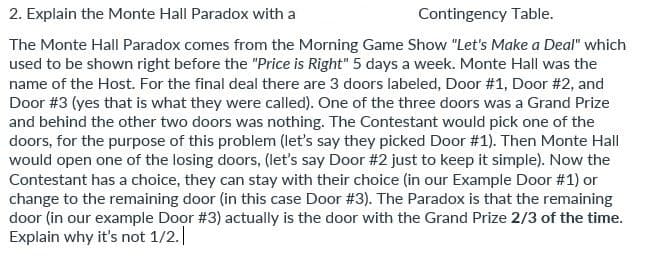2. Explain the Monte Hall Paradox with a Contingency Table. The Monte Hall Paradox comes from the Morning Game Show "Let's Make a Deal" which used to be shown right before the "Price is Right" 5 days a week. Monte Hall was the name of the Host. For the final deal there are 3 doors labeled, Door #1, Door #2, and Door #3 (yes that is what they were called). One of the three doors was a Grand Prize and behind the other two doors was nothing. The Contestant would pick one of the doors, for the purpose of this problem (let's say they picked Door #1). Then Monte Hall would open one of the losing doors, (let's say Door #2 just to keep it simple). Now the Contestant has a choice, they can stay with their choice (in our Example Door #1) or change to the remaining door (in this case Door #3). The Paradox is that the remaining door (in our example Door # 3) actually is the door with the Grand Prize 2/3 of the time. Explain why it's not 1/2.
2. Explain the Monte Hall Paradox with a Contingency Table. The Monte Hall Paradox comes from the Morning Game Show "Let's Make a Deal" which used to be shown right before the "Price is Right" 5 days a week. Monte Hall was the name of the Host. For the final deal there are 3 doors labeled, Door #1, Door #2, and Door #3 (yes that is what they were called). One of the three doors was a Grand Prize and behind the other two doors was nothing. The Contestant would pick one of the doors, for the purpose of this problem (let's say they picked Door #1). Then Monte Hall would open one of the losing doors, (let's say Door #2 just to keep it simple). Now the Contestant has a choice, they can stay with their choice (in our Example Door #1) or change to the remaining door (in this case Door #3). The Paradox is that the remaining door (in our example Door # 3) actually is the door with the Grand Prize 2/3 of the time. Explain why it's not 1/2.
MATLAB: An Introduction with Applications
6th Edition
ISBN:9781119256830
Author:Amos Gilat
Publisher:Amos Gilat
Chapter1: Starting With Matlab
Section: Chapter Questions
Problem 1P
Related questions
Question

Transcribed Image Text:2. Explain the Monte Hall Paradox with a
Contingency Table.
The Monte Hall Paradox comes from the Morning Game Show "Let's Make a Deal" which
used to be shown right before the "Price is Right" 5 days a week. Monte Hall was the
name of the Host. For the final deal there are 3 doors labeled, Door #1, Door #2, and
Door #3 (yes that is what they were called). One of the three doors was a Grand Prize
and behind the other two doors was nothing. The Contestant would pick one of the
doors, for the purpose of this problem (let's say they picked Door #1). Then Monte Hall
would open one of the losing doors, (let's say Door #2 just to keep it simple). Now the
Contestant has a choice, they can stay with their choice (in our Example Door #1) or
change to the remaining door (in this case Door #3). The Paradox is that the remaining
door (in our example Door #3) actually is the door with the Grand Prize 2/3 of the time.
Explain why it's not 1/2.
Expert Solution
This question has been solved!
Explore an expertly crafted, step-by-step solution for a thorough understanding of key concepts.
Step by step
Solved in 4 steps

Recommended textbooks for you

MATLAB: An Introduction with Applications
Statistics
ISBN:
9781119256830
Author:
Amos Gilat
Publisher:
John Wiley & Sons Inc

Probability and Statistics for Engineering and th…
Statistics
ISBN:
9781305251809
Author:
Jay L. Devore
Publisher:
Cengage Learning

Statistics for The Behavioral Sciences (MindTap C…
Statistics
ISBN:
9781305504912
Author:
Frederick J Gravetter, Larry B. Wallnau
Publisher:
Cengage Learning

MATLAB: An Introduction with Applications
Statistics
ISBN:
9781119256830
Author:
Amos Gilat
Publisher:
John Wiley & Sons Inc

Probability and Statistics for Engineering and th…
Statistics
ISBN:
9781305251809
Author:
Jay L. Devore
Publisher:
Cengage Learning

Statistics for The Behavioral Sciences (MindTap C…
Statistics
ISBN:
9781305504912
Author:
Frederick J Gravetter, Larry B. Wallnau
Publisher:
Cengage Learning

Elementary Statistics: Picturing the World (7th E…
Statistics
ISBN:
9780134683416
Author:
Ron Larson, Betsy Farber
Publisher:
PEARSON

The Basic Practice of Statistics
Statistics
ISBN:
9781319042578
Author:
David S. Moore, William I. Notz, Michael A. Fligner
Publisher:
W. H. Freeman

Introduction to the Practice of Statistics
Statistics
ISBN:
9781319013387
Author:
David S. Moore, George P. McCabe, Bruce A. Craig
Publisher:
W. H. Freeman